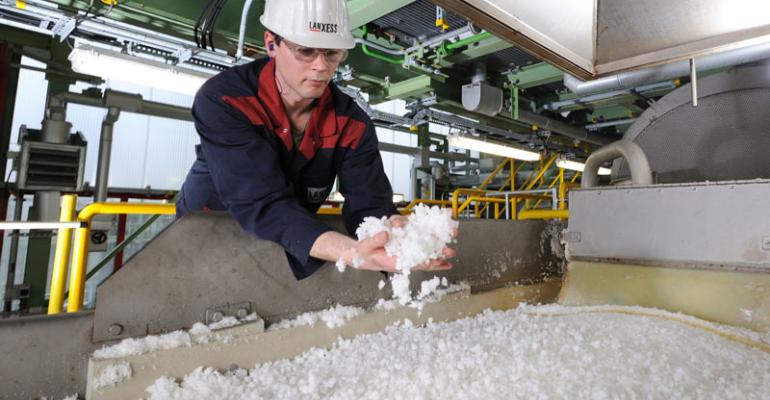CHARLOTTE, NC – Aiming to capitalize on auto makers’ growing need to cut weight and improve fuel efficiency, German specialty chemicals supplier Lanxess is making a big bet in automotive.
Last week, it announces the opening of its first U.S. production facility for advanced plastics and also showcases a prototype for a new tire that improves both fuel efficiency and grip.
Lanxess is not a household name in the U.S., but its former parent is German chemical and pharmaceutical giant Bayer. Lanxess was spun off in 2004 and had global sales of €8.8 billion ($11.4 billion) in 2011 and has 17,000 employees in 31 countries.
The company is investing $20 million in a new plant in Gastonia, NC, creating up to 45 new jobs. In the new compounding plant, basic polymers such as polyamide and polybutylene terephthalate are mixed and refined with special additives and glass fibers, for specific customer needs, to produce the company’s Durethan and Pocan brands of plastics.
Both high-tech plastics have a variety of automotive applications, including body parts, oil pans, coolant pipes, battery housings, steering rods, pedals and pedal brackets.
“With our new plant in Gastonia, we now are really close to our U.S. automotive customers and can support them in the development of lightweight, energy-saving vehicles even better than before,” CEO Axel Heitmann says.
Global demand for advanced plastics is expected to increase about 7% per year through 2020, Lanxess says. The plastic content of a typical car or truck can amount to about 20% by weight, and that figure is trending upwards.
The U.S. is the largest market for high-tech plastics, with the automotive industry at the forefront, Lanxess says. Tougher Corporate Average Fuel Economy standards aimed at doubling the fuel efficiency of U.S. vehicles by 2025 are driving demand for these advanced materials. The supplier plans to spend €125 million ($163 million) to expand its global production network for high-tech plastics during the next two years.
The company also is showcasing an “AA-rated” concept tire that was developed in Germany and tested by TÜV SÜD, an independent technical service organization.
The prototype tire uses the latest generation of neodymium-based performance rubber technology, as well as solution styrene butadiene rubber and rubber additives to achieve a grade of “A” for both rolling resistance and wet grip under the new European Union tire-labeling rules. It is one of the first tires in the world to achieve an AA rating, Lanxess says.
Nd-PBR is used in the treads and sidewalls of tires to help reduce rolling resistance and increase fuel efficiency. Nd-PBR is highly resistant to abrasion and plays a significant role in making tires safer and more durable. SSBR is used principally in the tread compounds of tires, where it helps reduce rolling resistance and improve wet grip.
Studies show 20% to 30% of a vehicle’s fuel consumption and 24% of its carbon-dioxide emissions are related to tires, Lanxess says.
The supplier does not want to actually make tires but play a leading role in helping its tire-producing customers develop tires of the future. “We now are moving from the age of tire design to the age of tire materials, which will make new gains in performance,” says CEO Heitmann.
If car owners replace conventional tires on their car with “green tires” – at an added cost of $20 to $30 per tire – they can achieve considerable fuel cost savings. Under ideal circumstances, gasoline consumption will decline by 5% to 7%, Lanxess says.
Studies also demonstrate the new-technology tires shorten the braking distance on wet or icy surfaces up to 15% and considerably improve general handling in the winter. This is significant, because low-rolling resistance often can degrade tire-performance characteristics such as braking and handling.



